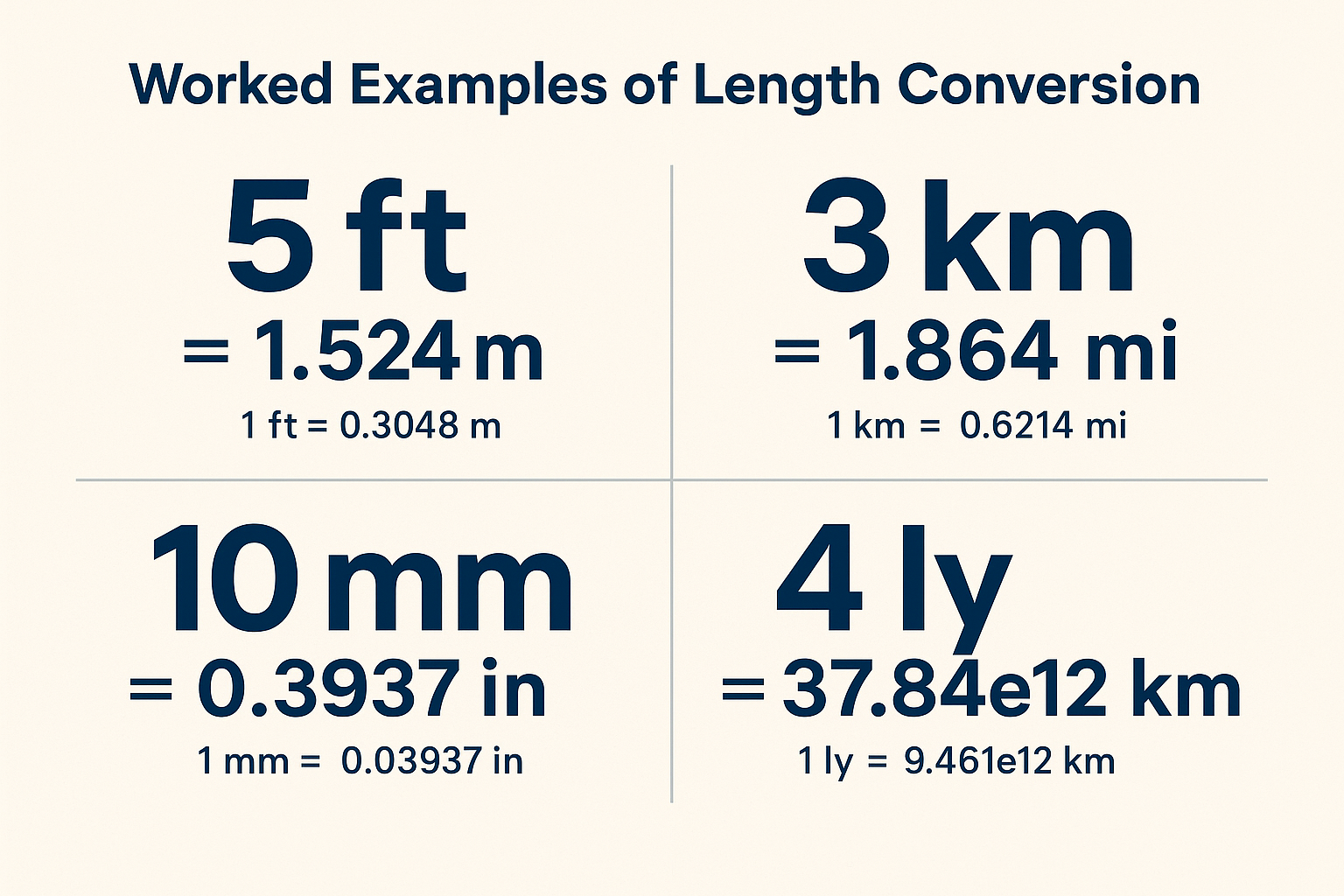Length Conversion Calculator
Inputs
Result
| Unit | Symbol | Value |
|---|
Embed this calculator
Adjust the size if needed, then copy the code below into your page or blog. The calculator will load in an iframe and stay updated automatically.
✅ Works on most website builders (WordPress, Elementor, HTML, etc.) · Please keep the credit link to support future free tools.
🔹 How to Use the Length Conversion Calculator
Convert between metric, imperial, and astronomical distance units in seconds. The dropdowns list all units (meter, kilometer, centimeter, millimeter, micrometer, nanometer, mile, yard, foot, inch, light year).
- Enter a value in the Value field (commas/spaces are OK; the parser cleans input).
- Select the source unit in From Unit (e.g., ft).
- Select the target unit in To Unit (e.g., m).
- (Optional) Adjust Decimals (0–10). Tiny results auto-increase precision to show meaningful digits.
- Click Convert or simply type—results update live. Use Swap to flip units, Reset to clear inputs.
🔹 Reading the Results
- Main result box: Shows the converted value plus a summary (e.g., 12 ft ➝ m).
- All-units table: Converts your input into every supported unit at once. On mobile, swipe horizontally.
- Very small/large numbers: We reveal significant digits up to 10 places and use scientific notation only when necessary.
🔹 What Is Length Conversion?
Length conversion is the process of changing a measurement from one unit of distance to another. Because different regions and fields use different standards, it’s essential to have a reliable way to switch between metric units (meters, kilometers, centimeters, millimeters) and imperial units (feet, inches, yards, miles). For scientific applications, extremely small (nanometers) and extremely large (light years) units are also used.
Our calculator simplifies these conversions by using exact standards defined by international organizations. For example:
- 1 inch = 2.54 cm (defined by international agreement)
- 1 mile = 1,609.344 m
- 1 light year ≈ 9.4607 × 1015 m
🔹 How Length Conversion Works
Every length conversion passes through a single pivot unit: the meter (m). To convert from unit A to unit B, first convert A → meters, then meters → B.
🔹 Exact Constants Used
These constants are defined by international standards and are used by the calculator:
| Unit | Symbol | Meters per 1 unit |
|---|---|---|
| Meter | m | 1 |
| Kilometer | km | 1,000 |
| Centimeter | cm | 0.01 |
| Millimeter | mm | 0.001 |
| Micrometer | µm | 1e-6 |
| Nanometer | nm | 1e-9 |
| Mile | mi | 1,609.344 |
| Yard | yd | 0.9144 |
| Foot | ft | 0.3048 |
| Inch | in | 0.0254 |
| Light Year | ly | 9.4607 × 1015 |
🔹 Step-by-Step Mini Examples
Example 1 — 12 ft to m: 12 × 0.3048 = 3.6576 m.
Example 2 — 5 km to mi: (5 × 1000) ÷ 1609.344 = 3.10686 mi.
Example 3 — 3 in to cm: (3 × 0.0254) ÷ 0.01 = 7.62 cm.
🔹 Worked Examples of Length Conversion
These examples show how to apply the conversion formula in real situations, step by step.
1 ft = 0.3048 m.
10 × 0.3048 = 3.048 m.
1 km = 1000 m, 1 mile = 1609.344 m.
(2 × 1000) ÷ 1609.344 = 1.2427 mi.
1 mm = 0.001 m, 1 in = 0.0254 m.
(2500 × 0.001) ÷ 0.0254 = 98.425 in.
1 ly = 9.4607 × 1015 m.
÷ 1000 = 9.4607 × 1012 km.

🔹 Real-Life Applications of Length Conversion
Length conversion is essential in everyday life, professional industries, and advanced sciences. Below are common use cases where converting between units ensures clarity, accuracy, and global understanding.
- Area Conversion Calculator — for surface conversions in design and real estate.
- Time Zone Calculator — helpful when scheduling global engineering or astronomy projects.
🔹 Frequently Asked Questions
• 0–2 decimals: everyday use (height, travel distance).
• 3–5 decimals: technical use (construction, manufacturing).
• 6–10 decimals: scientific use (nanotech, astronomy).
🔹 References & Sources
Conversion factors are derived from internationally accepted standards. Below are key references used for this calculator.
| Source | Description | Link |
|---|---|---|
| International System of Units (SI) | Defines the meter and derived units such as kilometer, centimeter, millimeter. | bipm.org |
| National Institute of Standards and Technology (NIST) | Provides exact definitions of inch, foot, yard, and mile in terms of meters. | nist.gov |
| NASA Astrophysics Data System | Reference for astronomical distances including light year conversions to meters. | ui.adsabs.harvard.edu |
| Calculator.net | Number 1 calculator website used for benchmarking features and structure. | calculator.net |
